Only through the comparison of cold data can we more clearly define our own position and gaps, as well as the direction of the future path.
Author: Joshua Wong, Binance Research
Translator: Will Awang
Recently, Binance Research released a report on Web3 payments, which effectively outlined the current status of traditional payments and blockchain Web3 payments, and looked ahead to the future of Web3 payments by combining the advantages brought by blockchain. The report is comprehensive, with sufficient arguments, and is worth learning from.
What inspired me the most is that the author, Joshua Wong, based on his background as a macro analyst, is able to place Web3 payments more within the entire traditional financial payment system in a data-driven manner, rather than purely pursuing on-chain technology.
Therefore, this article translates the Binance Research report and delves into its index articles. Only through the comparison of cold data can we more clearly define our own position and gaps, as well as the direction of the future path.
Below, Enjoy:
I. Core Points of the Report
Despite being one of the largest and fastest-growing industries globally, the payment industry still primarily relies on outdated bank infrastructure that has been in operation for 50 years. Modern payment fintech and card network organizations such as Stripe, Mastercard, and Visa have brought more convenient end-user experiences for consumers and merchants. However, the traditional costs involving as many as six intermediaries in each transaction (such as card organizations, issuers, processors, POS systems, payment aggregators, digital wallets) still exist. Blockchain technology provides a new global infrastructure track for payments, marking a fresh start.
Blockchain and its supported range of innovative applications have the potential to significantly reduce the cost of cross-border payments and improve their efficiency. This has already been achieved at the institutional level, with participants like Visa running pilots to settle institutional-level global payments on public blockchains. At the individual level, products like Binance Pay are being used for peer-to-peer payments and cross-border transfers in a faster and cheaper manner, as well as for direct cryptocurrency consumption at merchants without paying gas fees, automatically adjusting currency exchange, and settling in real-time.
The payment industry is of massive scale, which means the adoption of revolutionary technologies like blockchain may be slow and cautious. This also gives the blockchain industry itself the necessary time to grow and build the required payment tools and infrastructure.
II. Background Introduction
Using cash for face-to-face payments gives currency a unique sense of freedom. Unfortunately, modern digital payment systems cannot provide the ability for direct peer-to-peer transactions without the involvement of third parties. This is mainly because we need third parties to custody our funds, unlike blockchain technology, which can achieve self-custody of funds.
Even worse, the modern global payment infrastructure stack still relies on banks and other intermediaries to process any transactions. The current payment technology stack urgently needs a restart, and blockchain technology can achieve this.
When Bitcoin was introduced by an individual named Satoshi Nakamoto in 2009, it was envisioned as a revolutionary form of peer-to-peer electronic cash payment. The goal was to create a decentralized currency that could provide the same freedom for digital payments as face-to-face cash transactions, without the need for financial intermediaries such as banks. This vision promised to usher in a new era of financial freedom, transparency, and reduced transaction costs by facilitating direct transactions between individuals without the need for financial intermediaries.
The card network is an invaluable innovation that allows banks from around the world to communicate quickly. It is an extremely convenient system for consumers, allowing the use of a Visa/Mastercard to pay for goods and services worldwide. Therefore, they have become the primary means of digital payment in today's world. Visa and Mastercard are the two most valuable publicly traded companies in the world, ranking 18th and 20th, respectively.
In a typical open-loop payment system supported by card networks like Visa and Mastercard, there are up to 6 intermediaries between merchants and consumers.
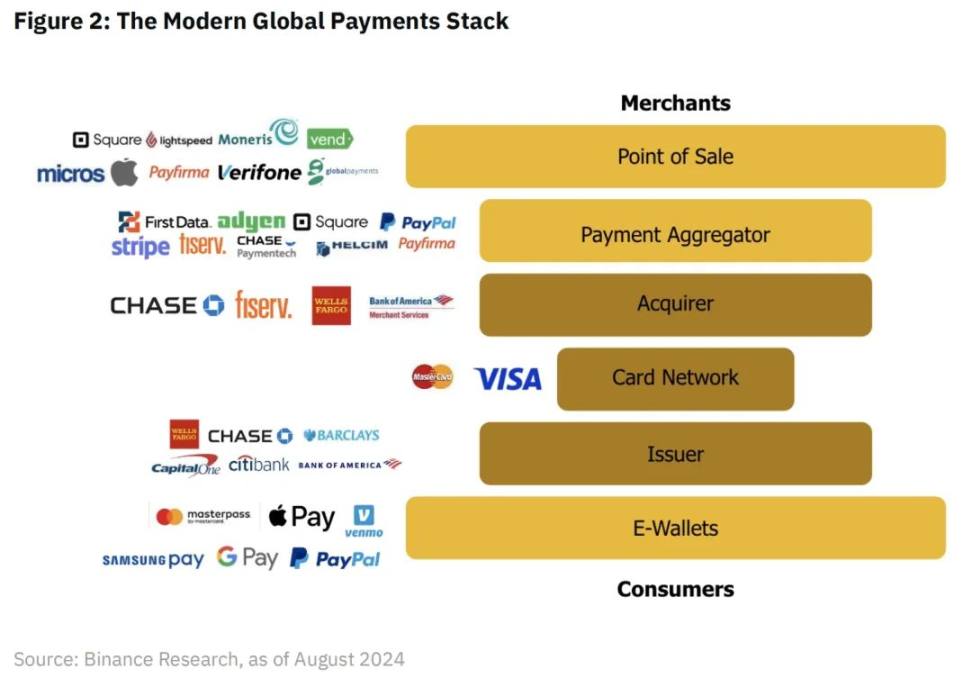
POS services are physical or digital terminals that initiate transactions. They capture payment details and send them for processing. For example, Square is one of the major POS service providers, charging merchants a fee of 2.6% + $0.10 per transaction. This fee is then distributed among the remaining 4 rent-collecting intermediaries in the payment stack (e-wallets like Apple Pay and Google Pay currently do not charge any per-transaction fees).
Payment aggregators integrate transactions from multiple merchants, simplifying the process of receiving payments. They provide a single integration point for various payment methods. Most payment aggregators (such as Stripe) also screen transactions for fraud to protect their merchant clients.
Acquirers are financial institutions that process credit or debit card payments on behalf of merchants. They ensure transactions are authorized and transfer funds from the issuer to the merchant's account.
Card networks facilitate the transmission of transaction information between acquirers and issuers. They establish rules and standards for card transactions.
Card issuers are banks or financial institutions that provide credit or debit cards to cardholders. They authorize transactions and debit the cardholder's account. Credit card networks like Visa and Mastercard also monitor transactions for fraud to protect their banking clients.
E-wallets store payment information and facilitate digital wallet for online and in-store transactions, providing users with a convenient way to make payments without directly using a credit card.
In short, blockchain can serve as an alternative, global, decentralized payment network—a new open system that is not bound by the current rent-collecting global payment system filled with intermediaries and the slow and expensive traditional banking system.
3.3 Closed Loop Payments
Closed-loop payments are an increasingly growing trend in the payment industry, promoted by companies like PayPal and Starbucks.
In a closed payment loop, consumers only interact with the PayPal application, as various merchants are onboarded by PayPal and can receive payments through the PayPal network. For Starbucks, customers can only use funds stored in the Starbucks digital wallet at the store. More and more merchants are starting to emulate Starbucks and implement their own closed payment loops. The main purpose of doing so is to deepen customer loyalty by running their own loyalty programs and bypassing the high fees charged by existing open payment stacks.
However, the existing closed payment loops are highly fragmented systems and still closely connected to the slow and expensive traditional banking system. To transfer funds into and out of the Starbucks closed loop, users still need a bank account. Additionally, many merchant-specific closed-loop systems (like Starbucks) do not allow transfers between customers and are not seamlessly usable in many countries. Blockchain technology provides another option for the future of payment fintech, allowing them to choose to completely bypass the traditional, fragmented banking system, ultimately reducing costs for merchants and consumers.
Binance Pay is an example of this payment fintech. It supports instant, low-cost peer-to-peer transfers and direct merchant payments within a closed-loop payment system. As a closed-loop model, next-generation fintech solutions like Binance Pay can provide familiar, sophisticated, and customizable fintech experiences for merchants and consumers, facilitating the transition from traditional banking tracks to blockchain tracks.
3.4 New Options for Cross-Border Payments
When it comes to cross-border transactions and remittances, costs can multiply. According to the International Monetary Fund, worker or immigrant remittances refer to "immigrants sending part of their income back home in cash or kind to support their families." This is a specific area of cross-border payments where blockchain technology can have a direct impact.
It is estimated that global remittance funds increased from $843 billion in 2022 to $857 billion in 2023, a growth of 1.6%. The growth rate is expected to reach 3% in 2024. In 2023, in current US dollars, the top five low- and middle-income countries receiving remittance inflows are India ($120 billion), Mexico ($66 billion), China ($50 billion), the Philippines ($39 billion), and Pakistan ($27 billion). According to World Bank data as of the first quarter of 2024, the average cost of remittances of $200 globally is still 6.35% of the transfer amount, totaling $54 billion in fees annually.
Due to the extremely high costs, cross-border remittances are a critical area of the payment industry where blockchain can truly have a significant impact.
Cross-border remittances involve transferring funds through a series of banks in different countries, a process that can take several days and is slow and costly.
1) The process begins when the remitter initiates the remittance at a local bank or remittance service, providing details of the recipient and the amount to be remitted.
2) Since the remitter's bank and the recipient's bank may not have a direct relationship, intermediary banks (referred to as correspondent banks) facilitate the transaction. The remitter's bank sends the funds to its correspondent bank, which may then transfer the funds to other correspondent banks, each of which charges a fee. The SWIFT network is typically used to send such payment instructions.
3) If different currencies are involved, funds are usually exchanged at one of the correspondent banks, often at a lower exchange rate.
4) Each bank must comply with anti-money laundering (AML) and know your customer (KYC) regulations, verify identities, and ensure the legitimacy of the transaction. Transactions are also screened against international sanction lists.
5) Once processed and compliance checks are completed, the funds are transferred to the recipient's bank, and the amount is credited to the recipient's account. The sender receives confirmation of the completed transaction.
The traditional payment system described above is not only costly and inefficient but also currently unable to reach a significant portion of the global population.
Today, as many as 1.4 billion adults worldwide do not have bank accounts. For these reasons, we see users around the world turning to blockchain solutions like Binance Pay for cheaper and faster cross-border transfers. Since 2022, Binance Pay's monthly active users and monthly transaction volume have grown nearly 5 times, with approximately 13.5 million users globally and around 1.96 million monthly transactions.
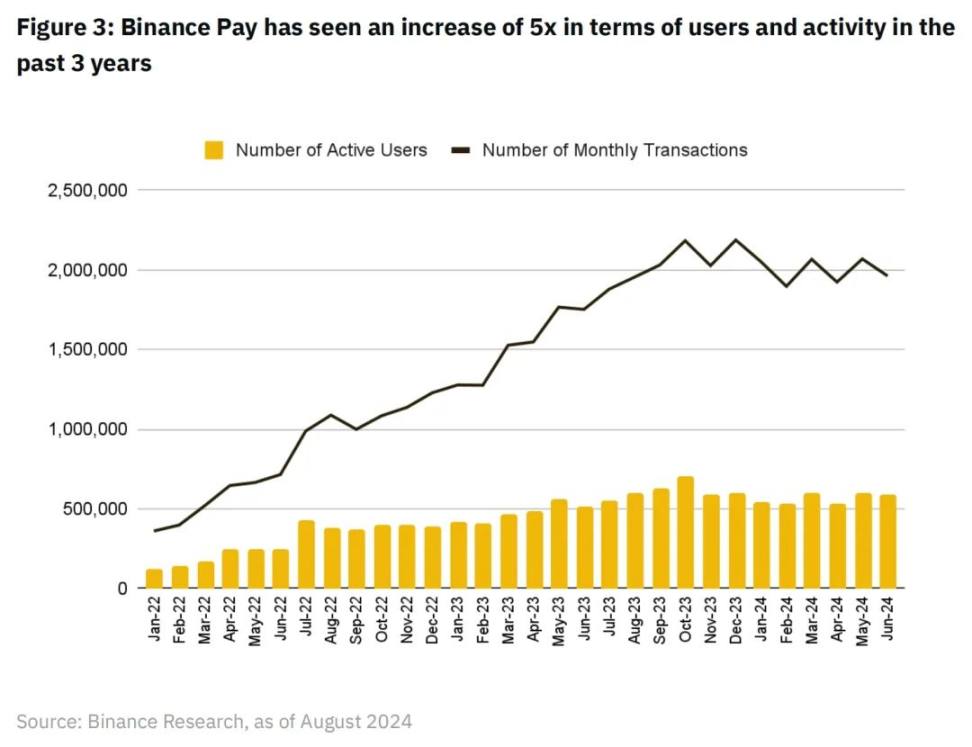
Blockchain and distributed ledger technology (DLT) have the potential to disrupt many existing participants in the payment industry, as they provide a unified, global, transparent payment environment accessible with just a smartphone and internet connection. This means there will be more direct communication channels between merchants and consumers, driven by distributed ledgers, and eliminates the need for correspondent banks. Liberating future fintech from traditional banking systems may be the key to achieving cheaper and faster global payments. Jason Clinton, Head of Sales at J.P. Morgan's European Financial Institutions Group, said, "Ultimately, we hope to achieve the ability to settle any payment in any currency instantly, anytime, anywhere, and this may require the use of blockchain technology."
IV. Current State of Blockchain-Based Payments
Due to the high cash equivalence of stablecoins, they have become a key component of blockchain payments. In 2023, the transaction volume of stablecoins exceeded $10.8 trillion, excluding activities such as machine or automated trading, the figure was $2.3 trillion.
Comparing stablecoin payments with traditional payments, we can see that in terms of quarterly transaction volume, they have consistently surpassed traditional payments.
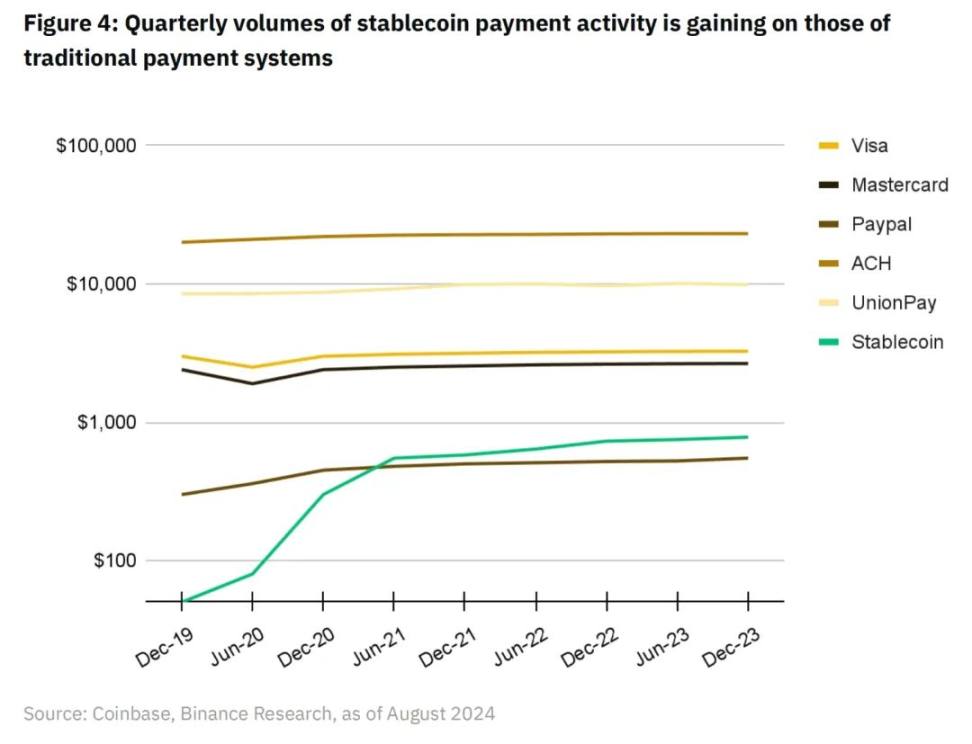
Since mid-2023, the total supply of stablecoins has been steadily increasing, indicating a steady growth in demand. The total market value of major stablecoins exceeds $160 billion, with USDT and USDC accounting for the largest share, with market shares of 73% and 21% respectively.
Utilizing the low volatility provided by stablecoins, the blockchain payment ecosystem and its related infrastructure have made significant progress since 2009.
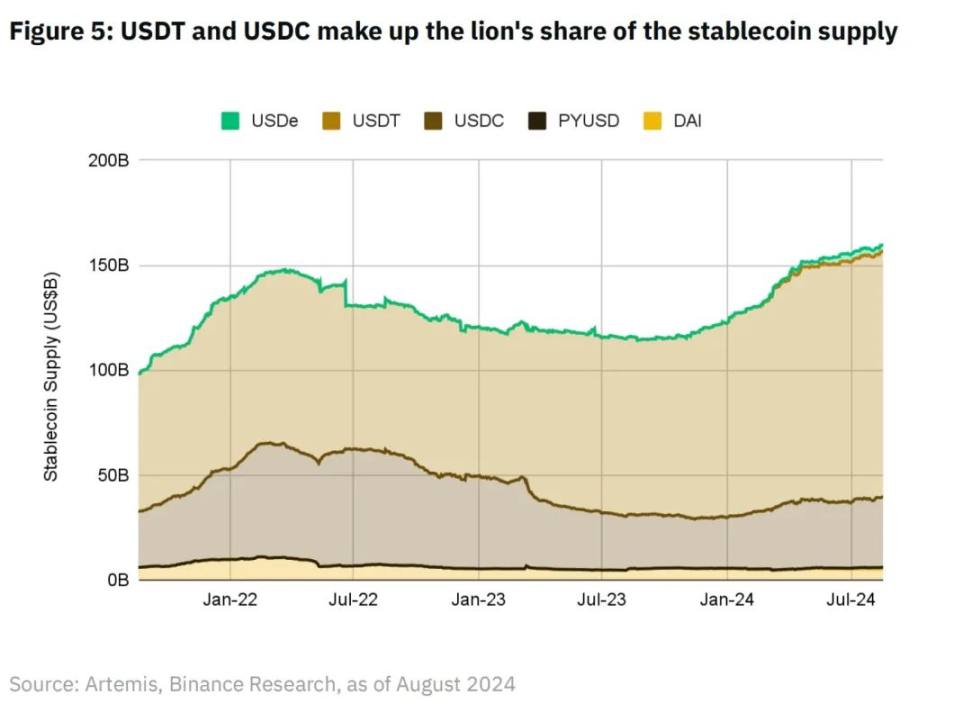
4.1 Infrastructure for Blockchain-Based Payments
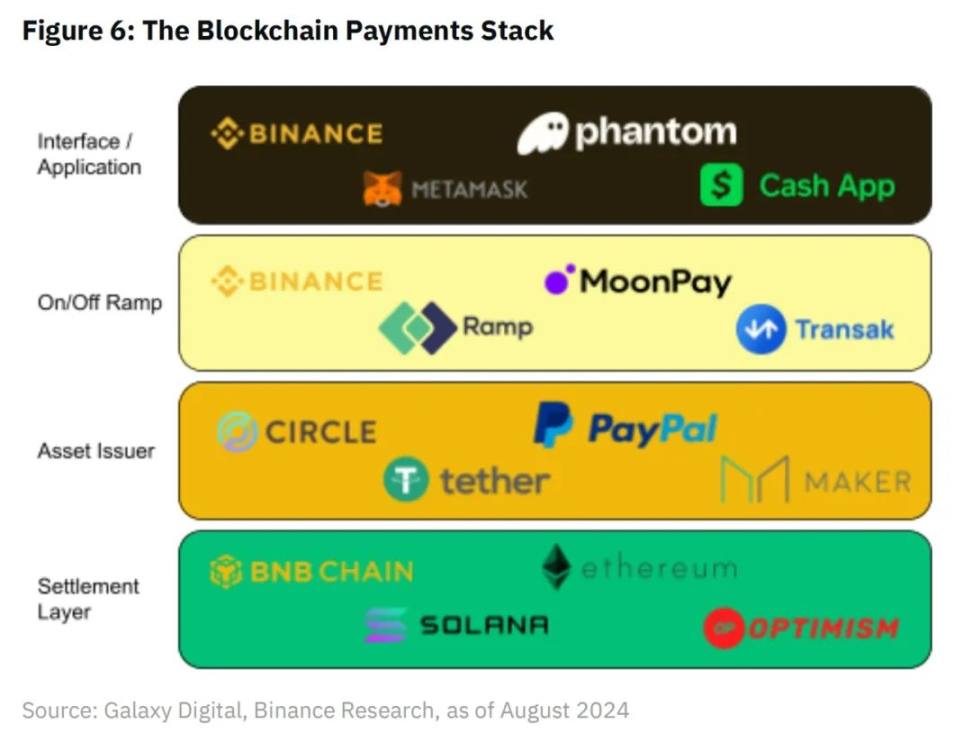
Settlement Layer
The blockchain infrastructure responsible for transaction settlement, such as Bitcoin, Ethereum, and Solana, are Layer1 blockchains, as well as multi-functional Layer2 solutions like Optimism and Arbitrum, essentially selling block space.
These platforms compete in speed, cost, scalability, security, and distribution. Over time, payment use cases may become significant consumers of block space.
We can imagine the settlement layer as the banking network that makes up the current traditional payment system. Consumers and merchants do not need to store funds in centrally managed bank accounts but can store assets in externally owned accounts (EOAs) or smart contract accounts on the chain.
It is worth noting that in the modern payment stack, authorization and settlement are handled separately. Card networks like Visa and Mastercard provide payment authorization services; issuing banks and acquiring banks are responsible for actual payment settlement. For blockchain, authorization and settlement can theoretically be done synchronously. Consumers can directly send a 100 USDT transaction from their EOA to the merchant's EOA by signing the transaction authorization, and validators will process and settle this transaction immutably on the blockchain.
However, it is worth noting that relying solely on blockchain for settlement and authorization of P2P payment transactions may mean bypassing the clearing, transaction monitoring, and fraud detection service systems used by payment aggregators like Stripe and credit card networks like Visa.
In recent years, Visa has been a pioneer in piloting blockchain for payment use cases, envisioning a future where "Visa's network involves not only multiple currencies and bank settlement channels but also multiple blockchain networks, stablecoins, and CBDCs or tokenized deposits."
Asset Issuer Layer
Asset issuers are organizations responsible for creating, managing, and redeeming stablecoins—a type of cryptocurrency designed to maintain a stable value relative to a reference asset or a basket of assets (most commonly the US dollar). These issuers typically operate on an asset-liability-driven business model similar to banks. They accept customer deposits, invest these funds in higher-yielding assets such as U.S. treasuries, and issue stablecoins as liabilities, profiting from the spread or net interest margin.
Asset issuers are a new type of "intermediary" in the crypto payment stack that does not have a direct equivalent in the traditional payment stack. Perhaps the closest equivalent is the government issuing fiat currency for transactions.
Unlike intermediaries in traditional payments, asset issuers do not charge fees for every transaction using their stablecoins. Once stablecoins are issued on-chain, they can be self-custodied and transferred without the need to pay any additional fees to the asset issuer.
On/Off Ramp Layer
On/Off ramp currency exchanges are crucial for increasing the usability and adoption of stablecoins in financial transactions. Fundamentally, they act as a technical bridge connecting stablecoins on the blockchain with the fiat system and bank accounts. Their business model is typically traffic-driven, accounting for only a small portion of the total dollar transaction volume processed through their platforms.
Currently, the on/off ramp layer is often the most expensive part of the crypto payment stack. Service providers like Moonpay charge fees as high as 1.5% to transfer assets from the blockchain to bank accounts.
In terms of cost, this aspect may be the biggest obstacle to widespread adoption of blockchain payments, especially for merchants and consumers who may still need fiat currency in bank accounts for daily transactions. To address this issue, products like Binance Pay are building their own merchant networks, allowing users to use cryptocurrencies directly without bearing the cost.
Interface/Application Layer
Front-end applications are customer-facing software in the crypto payment ecosystem, providing a user interface for supporting crypto transactions and leveraging other components of the stack to facilitate these payments. Their business model typically includes platform fees and transaction-based fees, earning revenue based on the volume of transactions processed through their interface.
4.2 Leveraging the Advantages of Blockchain-Based Payments
Near-Instant Settlement
When using Visa or Mastercard for transactions, consumers can experience the convenience of near-instant payment authorization. However, the actual settlement of the transaction, i.e., the transfer of funds from the customer's bank account (issuing bank) to the merchant's bank account (acquiring bank), typically takes at least a day to occur. While card networks allow consumers to make digital payments in seconds, merchants usually receive the funds for the purchase the next day or later. When funds need to be transferred across borders, settlement times are longer as it requires communication between banks in different countries.
In terms of remittance transaction times, the inefficiency of cross-border interbank communication systems is evident. It is somewhat counterintuitive that about 30% of remittances take more than a day to reach their destination; this percentage is higher than the 20% of cash remittances that take the same amount of time.
The World Bank attributes this to two reasons:
(1) Remittances cover traditional banking services, i.e., bank account to bank account services, which are slow.
(2) Most non-bank remittance service providers may pre-fund transactions to provide fast service for end-users using cash.
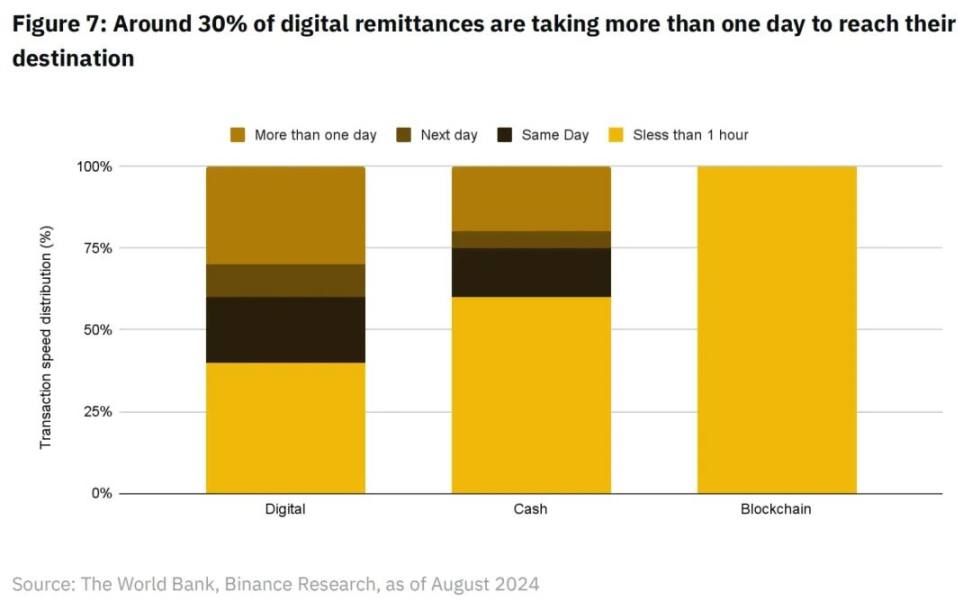
For example, among three payment mediums (digital, cash, and blockchain), blockchain is significantly ahead in terms of speed, with 100% of transactions being completed in less than an hour.
In 2021, Visa piloted a program with Crypto.com, using USDC and the Ethereum blockchain to process cross-border transaction payments for Crypto.com's real-time card program in Australia. Currently, Crypto.com uses USDC to fulfill its Visa card settlement obligations in Australia and plans to expand this functionality to other markets.
Before this pilot, settling cross-border purchases using the Crypto.com Visa card involved lengthy currency exchange processes and expensive international wire transfers.
Now, Crypto.com can use the Ethereum blockchain to directly send USDC cross-border to the Visa financial account managed by Circle, significantly reducing the time and complexity associated with international wire transfers.
At the individual user level, services like Binance Pay allow users to make instant cross-border transfers using cryptocurrencies.
Cost Reduction
According to data from the World Bank, the average cost of cross-border remittances has decreased from 6.39% in the fourth quarter of 2023 to 6.35% in the first quarter of 2024. Their breakdown of average costs by region shows that Sub-Saharan Africa is the region with the highest remittance costs, with an average cost of 7.73%.
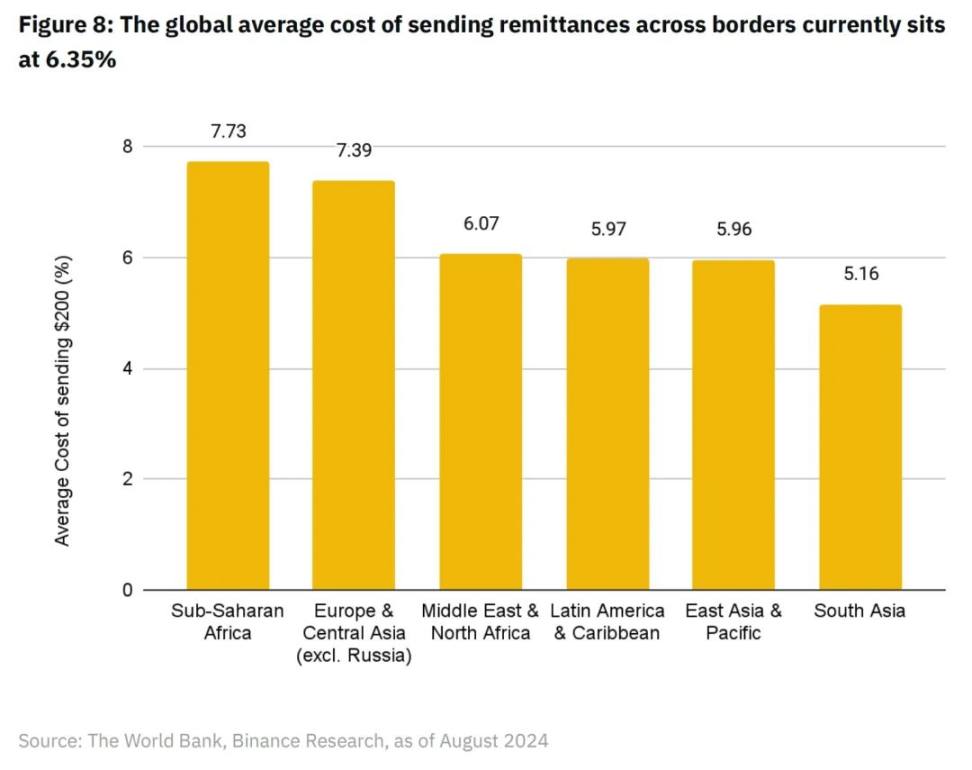
For comparison, the average cost of sending $200 worth of stablecoins (or any amount of stablecoins, as most blockchains charge a fixed gas fee unrelated to the transfer amount) through high-performance blockchains like Solana is approximately $0.00025. Products like Binance Pay allow users to make borderless peer-to-peer stablecoin transfers at a much lower cost, as long as the transfer amount is below 140,000 USDT. For values exceeding this amount, a fee of $1 is charged.
It is worth noting that currently, on/off-ramp currency exchanges are the most expensive part of any transaction involving on-chain assets. The service provided by CryptoConvert, with which Binance collaborated in the fourth quarter of 2023, allows South African consumers to purchase goods using their digital assets. This eliminates the need for on/off-ramp currency exchanges and marks the beginning of integrating merchant networks into a native closed-loop crypto payment cycle.
Transparent and Trustless Network
In an era where traditional payment systems like SWIFT are used for geopolitical purposes, blockchain technology provides a revolutionary alternative. With its inherent transparency, every transaction on the blockchain is recorded on an immutable ledger, visible to all network participants. This openness fosters trust and consensus, preventing fraud and manipulation.
Decentralization is another key advantage. Unlike centralized systems, blockchain distributes control across a vast network, reducing the risk of single points of failure and abuse of power. No single entity can impose sanctions or restrictions, ensuring a neutral and accessible global payment system. The decentralized nature of blockchain enhances its security, making it resistant to attacks. Infiltrating a blockchain network requires immense computational power, far exceeding traditional systems.
Furthermore, blockchain simplifies transactions by enabling peer-to-peer payments, reducing intermediaries, and lowering costs. Cross-border payments that used to take several days can now be completed in minutes, facilitating real-time global trade. Blockchain provides a viable global alternative to existing fragmented banking systems for storing and transferring digital value.
Challenges of Blockchain-Based Payments
Scalability and Performance
A globally usable payment network must support low-cost, fast transactions and operate 24/7. The ability to process thousands of transactions per second is crucial, as even momentary delays can have a significant impact on global business operations. For example, Visa processes over 65,000 transactions per second.
Solana holds the record for the highest transactions per second (TPS) generated by users, with a daily average TPS slightly exceeding 1,000. Sui follows closely, with reported peak TPS exceeding 850. BNB Chain ranks third in this metric, with 378.3 TPS.
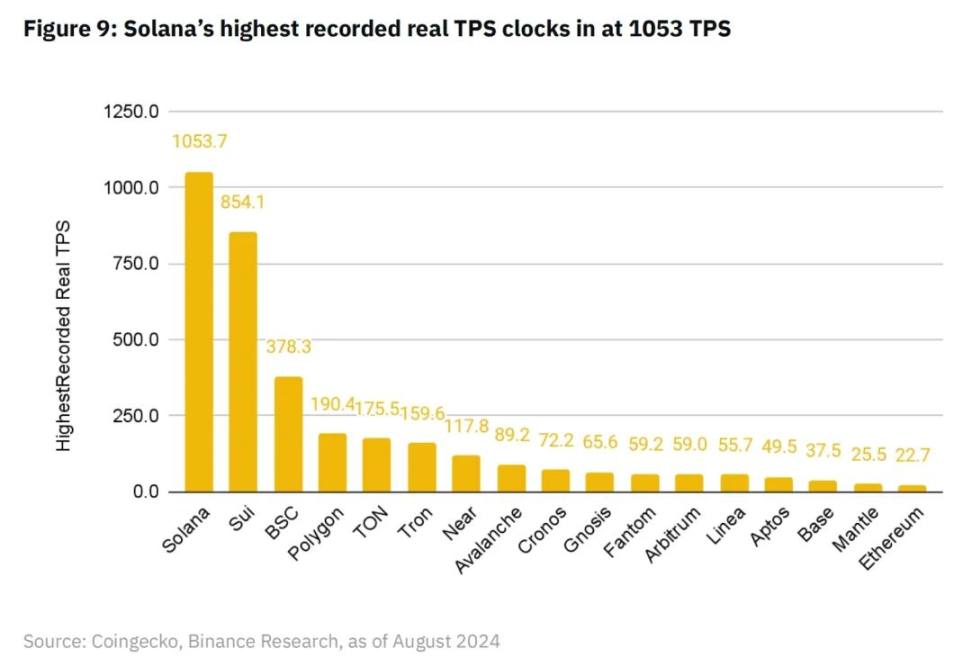
In 2023, Visa processed approximately 720 million transactions per day, resulting in an average TPS of about 8,300.
This is still nearly 8 times the maximum user-generated TPS recorded by Solana.
In addition to TPS issues, Solana has also experienced performance issues. Since its mainnet launch in 2020, Solana has experienced 7 major outages, causing block production to stall, with the most recent occurring in February 2024. Such severe incidents have made institutions cautious about relying on blockchain for critical business operations, such as payments.
However, despite these issues, Solana is still being adopted by numerous pioneering institutions. Due to its "proven high throughput levels," Visa describes it as "a viable test and pilot payment use case."
PayPal has also chosen Solana as the second chain to launch its PYUSD stablecoin after Ethereum. At the time of writing, despite being launched nearly a year later, the supply of PYUSD on Solana ($377 million) has surpassed the supply on Ethereum ($356 million).
Complexity on the Chain
Blockchain, largely due to its decentralized nature, has a certain level of complexity, making it less convenient for consumers and merchants to adopt compared to centralized systems. The requirements on end-users (such as private key management, paying gas fees, and the lack of a unified frontend) pose a significant challenge for ordinary consumers and merchants in adopting blockchain technology.
Meanwhile, in the past 5 years, payment fintech companies like Square and Stripe have elevated the payment experience for merchants and consumers to a very high level. Overall, they have achieved this by abstracting away all the underlying complexities of intermediaries, proxy banks, and other third parties. Therefore, in the context of the traditional global payment stack, from the perspective of consumers and merchants, what we have now is a highly refined system that constitutes up to 3% of the cost per transaction in traditional payment systems.
Fortunately, with the rise of faster and cheaper blockchain infrastructure, the UI/UX of blockchain applications has seen significant improvements. Binance Pay provides users with a familiar experience of centralized fintech while being free from the constraints of traditional banking systems. This allows users to freely send cryptocurrencies to each other globally at a low cost, while also having the option to easily withdraw crypto assets into self-custody (if they choose to do so).
Regulatory Uncertainty
The current regulatory environment for cryptocurrencies and blockchain technology is still evolving, bringing uncertainty for businesses and consumers. Regulations vary significantly across different countries, making global operations and cross-border transactions complex.
Countries like Switzerland and Singapore are developing clear regulatory frameworks to provide guidance and foster innovation in the blockchain space. The European Union's Markets in Crypto-Assets (MiCA) regulation is another example aimed at creating a coordinated regulatory environment. The blockchain industry is also developing compliance solutions to help businesses navigate the regulatory landscape. Providing individuals and businesses with the necessary tools to monitor and ensure compliance with anti-money laundering (AML) and know your customer (KYC) regulations is crucial for adoption.
The Future of Blockchain-Based Payments
Blockchain provides a unified technical infrastructure, simplifying the payment landscape and surpassing the fragmented nature of modern banking systems. As a globally distributed ledger, traditional banks rely on maintaining and synchronizing multiple centrally managed bank accounts, a inefficiency that blockchain eliminates. Therefore, blockchain offers a new medium that has the potential to lower costs and increase the speed of global payments.
As mentioned earlier in this report, payment giant Visa is experimenting with using blockchain as a cheaper and faster global settlement method for its institutional clients. Today, one of Visa's clients, Crypto.com, can cross-borderly send USDC directly to a Circle account managed by Visa through the Ethereum blockchain. This reduces the time and complexity of international wire transfers, which previously took several days to process. As companies become more familiar with blockchain technology, many may choose to transact using on-chain stablecoins instead of the slower and more expensive traditional banking systems.
At a smaller peer-to-peer scale, blockchain may have a faster and more significant impact on the global payment industry, especially in the field of cross-border remittances. Many remittance recipients lack bank accounts or have insufficient access to them. Blockchain technology offers the potential to "leapfrog" traditional banking systems, enabling anyone with internet access and a smartphone to quickly start receiving payments from anywhere in the world.
Fundamentally, blockchain provides a new, decentralized medium through which payments can be seamlessly conducted globally. As the modern payment industry continues to experiment with this new technology and integrate it into various parts of the global payment system, we should always keep in mind the ultimate goal of creating a cheaper, faster, and more efficient world of free currency for everyone.
免责声明:本文章仅代表作者个人观点,不代表本平台的立场和观点。本文章仅供信息分享,不构成对任何人的任何投资建议。用户与作者之间的任何争议,与本平台无关。如网页中刊载的文章或图片涉及侵权,请提供相关的权利证明和身份证明发送邮件到support@aicoin.com,本平台相关工作人员将会进行核查。




